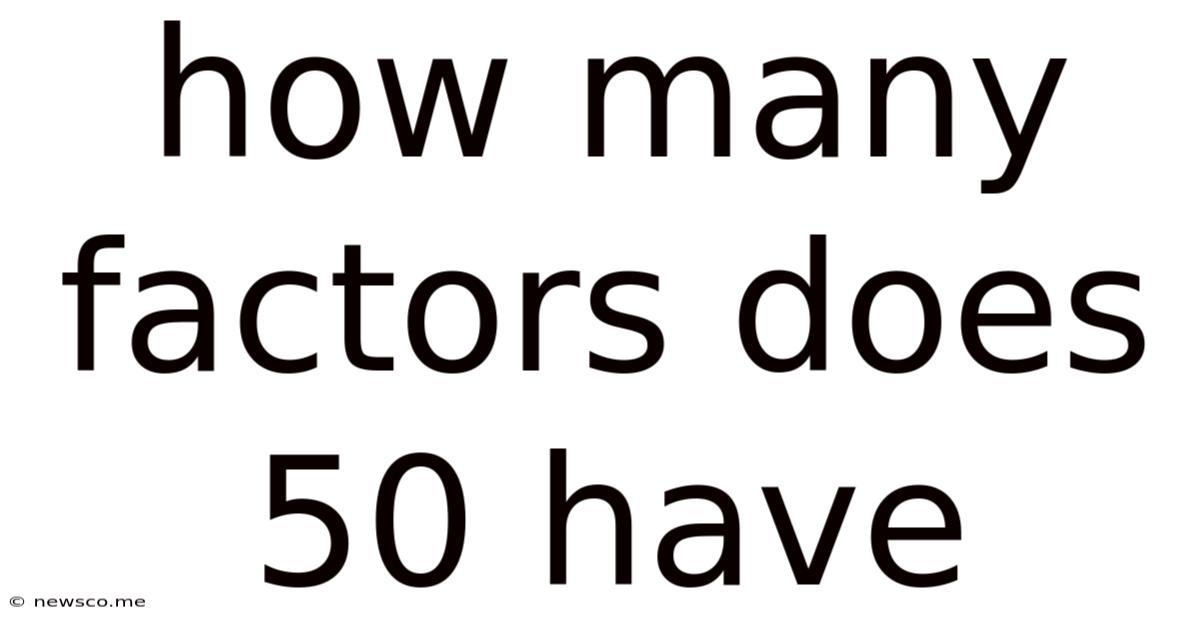How Many Factors Does 50 Have
News Co
Apr 19, 2025 · 4 min read

Table of Contents
How Many Factors Does 50 Have? A Deep Dive into Prime Factorization and Divisibility
Determining the number of factors a number possesses is a fundamental concept in number theory. Understanding this involves grasping the concept of prime factorization and how it relates to the total number of divisors. This article will explore the different methods to find the number of factors of 50, explain the underlying mathematical principles, and delve deeper into related concepts, making it a comprehensive guide for anyone interested in number theory.
Understanding Factors and Divisors
Before we tackle the specific case of 50, let's clarify the terminology. Factors and divisors are essentially interchangeable terms. They represent whole numbers that divide evenly into a given number without leaving a remainder. For example, the factors of 12 are 1, 2, 3, 4, 6, and 12 because each of these numbers divides 12 without leaving a remainder.
Prime Factorization: The Key to Finding Factors
The most efficient way to determine the number of factors of any number is through its prime factorization. Prime factorization is the process of expressing a number as a product of its prime factors. Prime numbers are whole numbers greater than 1 that are only divisible by 1 and themselves (e.g., 2, 3, 5, 7, 11, etc.).
Let's find the prime factorization of 50:
- Step 1: Start by dividing 50 by the smallest prime number, 2: 50 ÷ 2 = 25.
- Step 2: Now, 25 is not divisible by 2, so we move to the next prime number, 5: 25 ÷ 5 = 5.
- Step 3: 5 is a prime number itself.
Therefore, the prime factorization of 50 is 2 x 5 x 5, which can also be written as 2¹ x 5².
Calculating the Number of Factors
Once we have the prime factorization, calculating the total number of factors is straightforward. We use the exponents of the prime factors in the following way:
Add 1 to each exponent in the prime factorization, and then multiply the results.
In the case of 50 (2¹ x 5²):
- The exponent of 2 is 1. Adding 1 gives us 1 + 1 = 2.
- The exponent of 5 is 2. Adding 1 gives us 2 + 1 = 3.
- Multiply these results: 2 x 3 = 6.
Therefore, 50 has a total of six factors.
Listing the Factors of 50
Let's verify this by listing all the factors of 50:
1, 2, 5, 10, 25, 50
As you can see, there are indeed six factors.
Expanding the Concept: Factors of Larger Numbers
The method described above works for any number, regardless of its size. Let's consider a larger example: finding the number of factors of 360.
- Prime Factorization: 360 = 2³ x 3² x 5¹
- Adding 1 to each exponent: (3 + 1) x (2 + 1) x (1 + 1) = 4 x 3 x 2 = 24
- Total number of factors: 360 has 24 factors.
This demonstrates the power and efficiency of prime factorization in determining the number of factors.
Perfect Numbers and Abundant Numbers: Exploring Related Concepts
The number of factors of a number has connections to other interesting concepts in number theory. Let's explore two such concepts:
Perfect Numbers
A perfect number is a positive integer that is equal to the sum of its proper divisors (divisors excluding the number itself). The first few perfect numbers are 6, 28, 496, and 8128. The number of factors plays a role in determining whether a number is perfect, although the relationship is not straightforward.
Abundant Numbers
An abundant number is a number where the sum of its proper divisors is greater than the number itself. For example, 12 is an abundant number because the sum of its proper divisors (1 + 2 + 3 + 4 + 6 = 16) is greater than 12. Again, the number of factors influences whether a number is abundant, but it's not the sole determinant.
Applications of Factorization: Beyond Number Theory
Understanding prime factorization and the number of factors extends beyond the realm of pure mathematics. It finds applications in various fields, including:
-
Cryptography: Prime factorization is the foundation of many widely used encryption algorithms, like RSA. The difficulty of factoring large numbers into their prime components is crucial for the security of these systems.
-
Computer Science: Efficient algorithms for factorization are essential for various computational tasks, including optimization problems and database management.
-
Coding Theory: Factorization is used in error-correcting codes, which are essential for reliable data transmission and storage.
Conclusion: Mastering the Art of Factor Finding
Determining the number of factors a number has, like 50 in our example, is a seemingly simple problem with far-reaching implications. By mastering prime factorization and the associated calculation method, we unlock a deeper understanding of number theory and its applications across multiple disciplines. This knowledge provides a solid foundation for exploring more advanced concepts within mathematics and computer science. Remember, the key lies in breaking down the number into its prime components; once you have that, finding the total number of factors becomes a straightforward process. So, next time you encounter a number, don't just see a collection of digits—see a potential prime factorization waiting to be explored.
Latest Posts
Related Post
Thank you for visiting our website which covers about How Many Factors Does 50 Have . We hope the information provided has been useful to you. Feel free to contact us if you have any questions or need further assistance. See you next time and don't miss to bookmark.